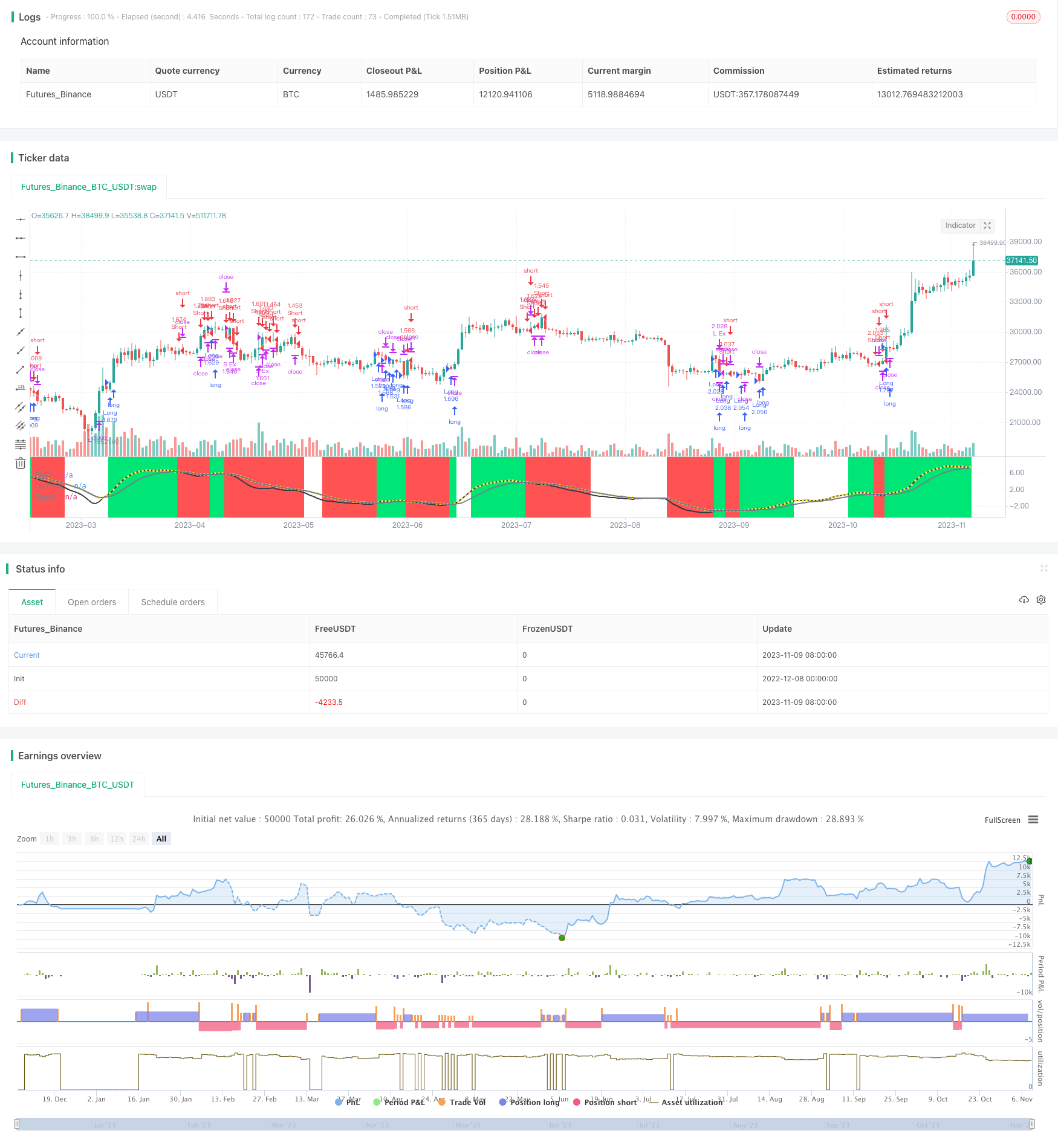
概述
动量指标决策交易策略是一种趋势跟踪策略。它使用双指数移动平均线构建动量指标,然后结合价格的变化率指标来产生交易信号。当动量指标上涨时,产生做多信号;当动量指标下跌时,产生做空信号。该策略适用于追踪市场中期趋势的交易者。
策略原理
该策略使用双指数移动平均线指标Decision Point oscillator来测量动量。首先计算价格的每日变化率,然后使用长度为31天和20天的双指数移动平均线分别平滑价格变化率,最后用9天的平滑移动平均线来发出交易信号。当快线高于慢线时为多头市场,当快线低于慢线时为空头市场。
该策略还引入价格变化率指标,以避免在盘整市场中产生错误信号。具体来说,是计算近30天价格的百分比变化率,通过其移动平均线来判断市场是否处于活跃状态。只有在市场活跃时,才会发出交易信号。
优势分析
该策略结合动量指标和价格变化率指标,可以有效识别中期趋势,避免在震荡行情中频繁交易。相比简单跟踪移动平均线等趋势策略,它可以大幅度降低错误交易的概率。此外,风险控制方面设置了止损点,可以及时止损,有效控制单笔损失。
风险分析
该策略主要 BASE在中长线趋势交易,无法捕捉短期价格波动。当出现剧烈行情时,止损点可能会被突破,导致较大亏损。此外,参数设置不当也会对策略产生影响。例如双指数移动平均线参数设置过短,会增加错误交易的概率。
要防范风险,可以适当调整止损点,扩大止损幅度。也可以在剧烈行情来临时,暂时关闭策略,避免止损被突破的概率。参数调整方面,应该进行详细的回测,选择最优参数。
优化方向
该策略可以从以下几个方向进行优化:
增加其他过滤指标,如波动率指标,可以避免行情剧烈波动期间的交易。
增加机器学习模型,辅助判断趋势方向和力度,可以提高信号的准确性。
尝试不同的动量指标,如相对强弱指标、Stochastic oscillator等,优化买卖时机。
实盘运行过程中,结合最近期行情特点,动态调整参数,追求最优参数组合。
总结
动量指标决策交易策略整体来说是一种稳健的中长期趋势跟踪策略。它结合双指数移动平均线动量指标和价格变化率指标,可以有效识别趋势,避免错误交易。同时,设置止损点来控制风险。如果参数调整合理,回测效果良好,则适合中长线追求超额收益的投资者。当然,交易者仍需警惕行情剧烈波动给策略带来的冲击风险。
/*backtest
start: 2022-12-08 00:00:00
end: 2023-11-10 00:00:00
period: 1d
basePeriod: 1h
exchanges: [{"eid":"Futures_Binance","currency":"BTC_USDT"}]
*/
//@version=4
strategy("Decision BF", overlay=false, initial_capital=10000, default_qty_type=strategy.percent_of_equity, default_qty_value=100, commission_type=strategy.commission.percent, commission_value=0.075)
/////////////// Time Frame ///////////////
testStartYear = input(2017, "Backtest Start Year")
testStartMonth = input(1, "Backtest Start Month")
testStartDay = input(1, "Backtest Start Day")
testPeriodStart = timestamp(testStartYear,testStartMonth,testStartDay, 0, 0)
testStopYear = input(2019, "Backtest Stop Year")
testStopMonth = input(12, "Backtest Stop Month")
testStopDay = input(31, "Backtest Stop Day")
testPeriodStop = timestamp(testStopYear,testStopMonth,testStopDay, 0, 0)
testPeriod() => true
/////////////// Decision ///////////////
src = input(ohlc4, title="Source")
length1 = input(31, title="First Smoothing")
length2 = input(20, title="Second Smoothing")
siglength = input(9, title="Signal Smoothing")
fr = input(true, title="Fill Region")
calc_csf(src, length) =>
sm = 2.0 / length
csf = 0.0
csf := (src - nz(csf[1])) * sm + nz(csf[1])
csf
i = (src / nz(src[1], src)) * 100
pmol2 = calc_csf(i - 100, length1)
pmol = calc_csf(10 * pmol2, length2)
pmols = ema(pmol, siglength)
d = pmol - pmols
duml = plot(fr ? (d > 0 ? pmol : pmols) : na, style=plot.style_circles, color=color.yellow, linewidth=0, title="DummyL")
hc = d > 0 ? d > d[1] ? color.lime : color.green : d < d[1] ? color.red : color.orange
///////////// Rate Of Change /////////////
source = close
roclength = input(30, minval=1)
pcntChange = input(7, minval=1)
roc = 100 * (source - source[roclength]) / source[roclength]
emaroc = ema(roc, roclength / 2)
isMoving() => emaroc > (pcntChange / 2) or emaroc < (0 - (pcntChange / 2))
/////////////// Strategy ///////////////
long = d > 0 and isMoving()
short = d < 0 and isMoving()
last_long = 0.0
last_short = 0.0
last_long := long ? time : nz(last_long[1])
last_short := short ? time : nz(last_short[1])
long_signal = crossover(last_long, last_short)
short_signal = crossover(last_short, last_long)
last_open_long_signal = 0.0
last_open_short_signal = 0.0
last_open_long_signal := long_signal ? open : nz(last_open_long_signal[1])
last_open_short_signal := short_signal ? open : nz(last_open_short_signal[1])
last_long_signal = 0.0
last_short_signal = 0.0
last_long_signal := long_signal ? time : nz(last_long_signal[1])
last_short_signal := short_signal ? time : nz(last_short_signal[1])
in_long_signal = last_long_signal > last_short_signal
in_short_signal = last_short_signal > last_long_signal
last_high = 0.0
last_low = 0.0
last_high := not in_long_signal ? na : in_long_signal and (na(last_high[1]) or high > nz(last_high[1])) ? high : nz(last_high[1])
last_low := not in_short_signal ? na : in_short_signal and (na(last_low[1]) or low < nz(last_low[1])) ? low : nz(last_low[1])
sl_inp = input(2.0, title='Stop Loss %') / 100
tp_inp = input(5000.0, title='Take Profit %') / 100
take_level_l = strategy.position_avg_price * (1 + tp_inp)
take_level_s = strategy.position_avg_price * (1 - tp_inp)
since_longEntry = barssince(last_open_long_signal != last_open_long_signal[1])
since_shortEntry = barssince(last_open_short_signal != last_open_short_signal[1])
slLong = in_long_signal ? strategy.position_avg_price * (1 - sl_inp) : na
slShort = strategy.position_avg_price * (1 + sl_inp)
long_sl = in_long_signal ? slLong : na
short_sl = in_short_signal ? slShort : na
/////////////// Execution ///////////////
if testPeriod()
strategy.entry("Long", strategy.long, when=long)
strategy.entry("Short", strategy.short, when=short)
strategy.exit("L Ex", "Long", stop=long_sl, limit=take_level_l, when=since_longEntry > 0)
strategy.exit("S Ex", "Short", stop=short_sl, limit=take_level_s, when=since_shortEntry > 0)
/////////////// Plotting ///////////////
sigl = plot(false ? na : pmols, title="PMO Signal", color=color.gray, linewidth=2, title="Signal")
mdl = plot(false ? na : pmol, title="PMO", color=color.black, linewidth=2, title="PMO")
fill(duml, sigl, color.green, transp=20, title="PosFill")
fill(duml, mdl, color.red, transp=20, title="NegFill")
bgcolor(isMoving() ? long ? color.lime : short ? color.red : na : color.white, transp=70)
bgcolor(long_signal ? color.lime : short_signal ? color.red : na, transp=50)